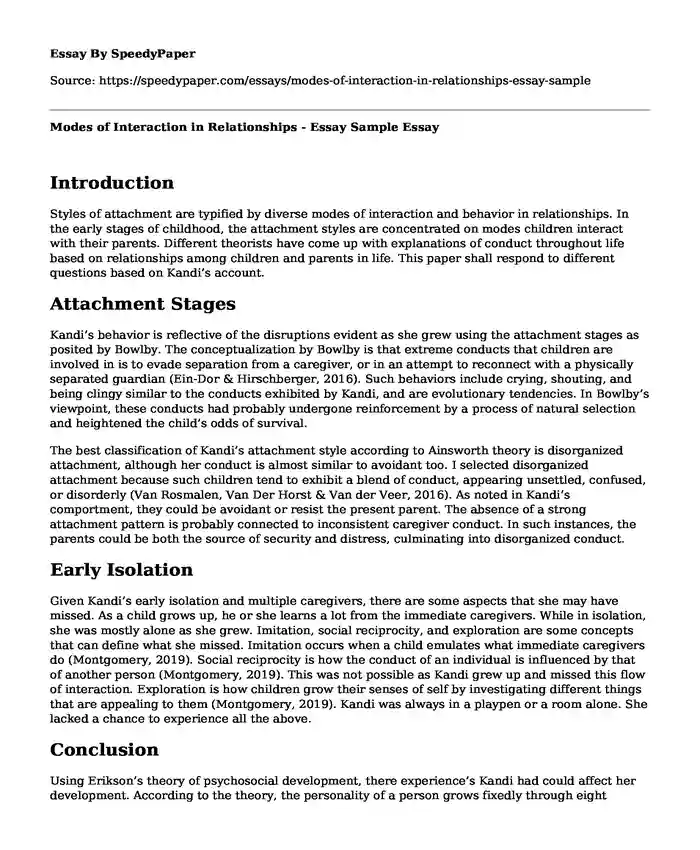
| Type of paper: | Essay |
| Categories: | Parenting Relationship Childhood Behavior |
| Pages: | 3 |
| Wordcount: | 683 words |
Introduction
Styles of attachment are typified by diverse modes of interaction and behavior in relationships. In the early stages of childhood, the attachment styles are concentrated on modes children interact with their parents. Different theorists have come up with explanations of conduct throughout life based on relationships among children and parents in life. This paper shall respond to different questions based on Kandi’s account.
Attachment Stages
Kandi’s behavior is reflective of the disruptions evident as she grew using the attachment stages as posited by Bowlby. The conceptualization by Bowlby is that extreme conducts that children are involved in is to evade separation from a caregiver, or in an attempt to reconnect with a physically separated guardian (Ein-Dor & Hirschberger, 2016). Such behaviors include crying, shouting, and being clingy similar to the conducts exhibited by Kandi, and are evolutionary tendencies. In Bowlby’s viewpoint, these conducts had probably undergone reinforcement by a process of natural selection and heightened the child’s odds of survival.
The best classification of Kandi’s attachment style according to Ainsworth theory is disorganized attachment, although her conduct is almost similar to avoidant too. I selected disorganized attachment because such children tend to exhibit a blend of conduct, appearing unsettled, confused, or disorderly (Van Rosmalen, Van Der Horst & Van der Veer, 2016). As noted in Kandi’s comportment, they could be avoidant or resist the present parent. The absence of a strong attachment pattern is probably connected to inconsistent caregiver conduct. In such instances, the parents could be both the source of security and distress, culminating into disorganized conduct.
Early Isolation
Given Kandi’s early isolation and multiple caregivers, there are some aspects that she may have missed. As a child grows up, he or she learns a lot from the immediate caregivers. While in isolation, she was mostly alone as she grew. Imitation, social reciprocity, and exploration are some concepts that can define what she missed. Imitation occurs when a child emulates what immediate caregivers do (Montgomery, 2019). Social reciprocity is how the conduct of an individual is influenced by that of another person (Montgomery, 2019). This was not possible as Kandi grew up and missed this flow of interaction. Exploration is how children grow their senses of self by investigating different things that are appealing to them (Montgomery, 2019). Kandi was always in a playpen or a room alone. She lacked a chance to experience all the above.
Conclusion
Using Erikson’s theory of psychosocial development, there experience’s Kandi had could affect her development. According to the theory, the personality of a person grows fixedly through eight phases of psychosocial growth, from infancy to adult life (Çelik & Ergün, 2016). In each phase, an individual encounters a psychosocial crisis that may carry positive or negative connotations for the growth of a person’s personality. Erikson posits that such crises are psychosocial since they comprise of the psychological necessities of a person differing with the societal needs (Çelik & Ergün, 2016). The tenet maintains that the fruitful completion of each phase leads to a healthy personality and gaining of basic human qualities. Basic qualities are elements that someone’s ego can utilize to solve future crises. The phases in Kandi’s life were undesirable mostly leading to negative outcomes and have the power to negatively impact her development.
References
Çelik, B., & Ergün, E. (2016). An Integrated Approach Of Erikson’s Psychosocial Theory And Adlerian Counselling. The International Journal of Human and Behavioral Science, 2(1), 20-26.
Ein-Dor, T., & Hirschberger, G. (2016). Rethinking Attachment Theory: From A Theory Of Relationships To A Theory Of Individual And Group Survival. Current Directions in Psychological Science, 25(4), 223-227.
Montgomery, M. J. (2019). Identity Development Theories. The Encyclopedia of Child and Adolescent Development, 1-12.
Van Rosmalen, L., Van Der Horst, F. C., & Van der Veer, R. (2016). From Secure Dependency To Attachment: Mary Ainsworth’s Integration Of Blatz’s Security Theory Into Bowlby’s Attachment Theory. History of Psychology, 19(1), 22.
Cite this page
Modes of Interaction in Relationships - Essay Sample. (2024, Jan 01). Retrieved from https://speedypaper.com/essays/modes-of-interaction-in-relationships-essay-sample
Request Removal
If you are the original author of this essay and no longer wish to have it published on the SpeedyPaper website, please click below to request its removal:
- Free Essay with a Professional Psychosocial Report
- Free Essay on Babies Born To Drug-Addicted Mothers
- Five Schools of Behaviorism - Free Essay
- Employee Performance Driven by Work Environment Motivation & Rewards - Essay Example
- Essay on Nursing Evolution: Embracing the Six Ways of Knowing for Improved Healthcare and Patient Relations
- Report Example on Emotions, Stress, and Behavior: Navigating the Complex Interplay
- Sacred Bonds: A Letter of Love, Commitment, and Spiritual Unity
Popular categories




